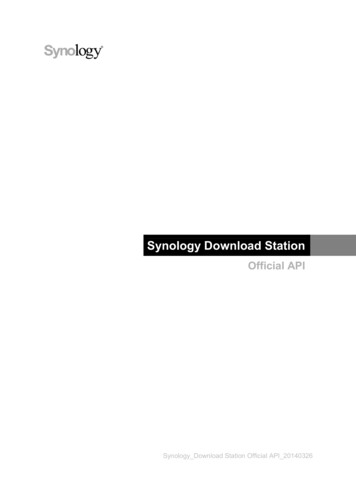
Transcription
Psychology RevivalsObsessive-Compulsive DisorderObsessive-compulsive disorder is now recognized to be a serious and chronicillness affecting more than 2% of the population. While the last decade of thetwentieth century witnessed many advances on both the pharmacological andthe behavioral fronts, fewer than 50% of cases benefitted significantly fromtreatments available at the time. In this volume, originally published in2000, leading authorities offer a comprehensive, cutting-edge overview ofetiology, diagnosis, assessment, and the latest cognitive-behavioral, biological,and combined approaches to intervention. A special focus is treatment-resistant illness.Obsessive-Compulsive Disorder: Contemporary Issues in Treatment will be an indispensable resource for all professionals who seek better solutions to the oftenseemingly intractable problems of their OCD clients.
Obsessive-Compulsive DisorderContemporary issues in treatmentEdited byWayne K. GoodmanMatthew V. RudorferJack D. Maser
First published in 2000by Lawrence Erlbaum Associates, IncThis edition first published in 2016 by Routledge2 Park Square, Milton Park, Abingdon, Oxon OX14 4RNand by Routledge711 Third Avenue, New York, NY 10017Routledge is an imprint of the Taylor & Francis Group, an informa business 2000 Lawrence Erlbaum Associates, IncThe right of Wayne K. Goodman, Matthew Rudorfer and Jack D. Maser to be identifiedas author of this work has been asserted by him in accordance with sections 77 and 78 ofthe Copyright, Designs and Patents Act 1988.All rights reserved. No part of this book may be reprinted or reproduced or utilised inany form or by any electronic, mechanical, or other means, now known or hereafterinvented, including photocopying and recording, or in any information storage orretrieval system, without permission in writing from the publishers.Publisher’s NoteThe publisher has gone to great lengths to ensure the quality of this reprint but pointsout that some imperfections in the original copies may be apparent.DisclaimerThe publisher has made every effort to trace copyright holders and welcomescorrespondence from those they have been unable to contact.A Library of Congress record exists under ISBN: 0805828370ISBN: 978-1-138-67478-3 (hbk)ISBN: 978-1-315-56107-3 (ebk)
Obsessive-Compulsive DisorderContemporary Issues in TreatmentEdited byWayne K. GoodmanUniversity of FloridaMatthew V. RudorferNational Institute of Mental HealthJack D. MaserUniversity of California, San Diego
Copyright 2000 by Lawrence Erlbaum Associates, Inc.All rights reserved. No part of this book may be reproduced in any form, by photostat, microfilm, retrieval system, or any other means, without prior written permissionof the publisher.Lawrence Erlbaum Associates, Inc., Publishers10 Industrial AvenueMahwah, NJ 07430[Co er design by Kathryn Houghtaling Lacey\Library of Congress Cataloging-in-Publication DataObsessive-compulsive disorder: contemporary issues intreatment / edited by Wayne K Goodman, Matthew V.Rudorfer, Jack D. Maser.p. em.Includes bibliographical references and index.ISBN 0-8058-2837-0 (cloth: alk. paper)1. Obsessive-compulsive disorder-Treatment.2. Phobias-Treatment. I. Goodman, W. K (Wayne K)II. Rudorfer, Matthew V. III. Maser, Jack D.RC533.0267 1999616.85'22706- lc2198-56188CIPBooks published by Lawrence Erlbaum Associates are printedon acid-free paper, and their bindings are chosen for strengthand durability.Printed in the United States of America10 9 8 7 6 5 4 3 2 1
ContentsList of ContributorsPrefaceixxiiiPART I. CLINICAL SUBTYPES AND SPECTRUM1Spectrum, Boundary, and Sub typing Issues: Implicationsfor Treatment-Refractory Obsessive-Compulsive DisorderEric Hollander and Cheryl M. Wong2Connection Between Obsessive-Compulsive Disorderand Body Dysmorphic DisorderKatharine A. Phillips233Tic-Related Versus Non-Tic-Related Obsessive-CompulsiveDisorderJames F. Leckman, Christopher J. McDougle, David L. Pauls,Bradley S. Peterson, Dorothy E. Grice, Robert A. King, LawrenceScahill, Lawrence H. Price, and Steven A. Rasmussen434Comorbid Schizophrenia: Implications for Treatmentof Obsessive-Compulsive DisorderMatthew J. Byerly, Wayne K. Goodman, and Carlos Cuadros693PART II. PATHOPHYSIOLOGY AND ETIOLOGY5 Clinical and Family-Genetic Studies of Childhood87Obsessive-Compulsive DisorderGregory L. Hannav
viCONTENTS6Information-Processing Abnormalities inObsessive-Compulsive Disorder105Richard J. McNally7Issues in Cognitive Treatment of Obsessive-CompulsiveDisorderPatricia van Oppen and Paul M. G. Emmelkamp1178Investigating Cortico-Striatal Pathophysiology in ObsessiveCompulsive Disorders: Procedural Learning and ImagingProbesScott L. Rauch and Cary R. Savage133PART III. ASSESSMENT9A Review of Assessment Measures for Obsessive-CompulsiveDisorderUlrike Feske and Dianne L. Chambless15710 Measuring Outcome in Drug Trials of Obsessive-Compulsive183DisorderSuck Won KimPART IV. COGNITIVE-BEHAVIORAL TREATMENTS11Psychological Treatment of Refractory Obsessive-CompulsiveDisorder and Related Problems201Paul M. Salkovskis, Candida Richards, and Elizabeth Forrester12 Inpatient Treatment of Refractory Obsessive-Compulsive22313233DisorderC. Alec PollardCognitive and Behavioral Treatment of ObsessiveCompulsive Spectrum DisordersFugen A. Neziroglu, Kevin P. Stevens, Brett Liquori,and Jose A. Yaryura-Tobias14 Predicting Treatment Outcome for Obsessive-CompulsiveDisorder: Effects of ComorbidityGail Steketee, Nathan J. Henninger, and C. Alec Pollard257
CONTENTSviiPART V. DRUG AND OTHER SOMATIC TREATMENTS15 Pharmacotherapy of Obsessive-Compulsive Disorder:27716 Preferential Efficacy of Serotonergic Medication in30317 Clomipramine in the Treatment of Obsessive-Compulsive31518 Biological Approaches to Treatment-Resistant Obsessive-33319 The Role of Neuroleptics in Treatment-Refractory Obsessive-37120Intravenous Clomipramine for Obsessive-CompulsiveDisorderBrian A. Fallon and Michael R. Liebowitz39321Benzodiazepines in the Treatment of Obsessive-CompulsiveDisorderWilliam A. Hewlett40522Electroconvulsive Therapy in Treatment-RefractoryObsessive-Compulsive DisorderMatthew V. Rudorfer431Overview and Treatment-Refractory StrategiesTeresa A. Pigott and Sheila SeayObsessive-Compulsive Disorder: From Practice to TheoryJulian Jancu, Pinhas N. Dannon, Michal Lustig,Yehuda Sasson, and Joseph ZoharDisorderJoseph DeVeaugh-Geiss and Richard KatzCompulsive DisorderWayne K. Goodman, Herbert E. Ward, Anita S. Kablinger,and Tanya K. MurphyCompulsive DisorderChristopher J. McDougle, C. Neill Epperson,and Lawrence H. Price23 Neurosurgical Treatment of Obsessive-Compulsive DisorderMichael A. Jenike457
CONTENTSviiiPART VI. COMBINED TREATMENT24 Combined Drug and Behavioral Treatments for48525 Cognitive Behavior Therapy and Pharmacotherapy501Obsessive-Compulsive Disorder: Early FindingsDavid A. Spiegelfor Obsessive-Compulsive Disorder: The NIMH-SponsoredCollaborative StudyMichael J. Kozak, Michael R. Liebowitz, and Edna B. FoaPART VII. MECHANISMS OF ACTION26 The Mechanisms of Behavioral Treatment and the Problem53327 Understanding the Mechanism of Action of Serotonin55128 Specific Brain System Mediation of Obsessive-Compulsive573of Therapeutic FailuresStanley Rachman and Rosamund ShafranReuptake Inhibitors in Obsessive-Compulsive Disorder:A Step Toward More Effective Treatments?Pierre Blier, Richard Bergeron, Graciela Pifieyro,and Mostafa El MansariDisorder Responsive to Either Medication or BehaviorTherapyLouis R. Baxter, Jr., Robert F. Ackermann, Neal R. Swerdlow,Arthur Brody, Sanjaya Saxena, Jeffrey M. Schwartz,Jane M. Gregoritch, Paula Stoessel, and Michael E. PhelpsAbout the Editors611Author Index613Subject Index653
List of ContributorsRobert F. Ackermann, Department of Behavioral Neurobiology, University ofAlabama at BirminghamLewis R. Baxter, Jr., Department of Psychiatry, University of Alabama atBirmingham, University of California, Los AngelesRichard Bergeron, Department of Psychiatry, Harvard Medical SchoolPierre Blier, Neurobiological Psychiatry Unit, McGill UniversityArthur Brody, Department of Psychiatry and Behavioral Science, University ofCalifornia, Los AngelesMatthew J. Byerly, Department of Psychiatry, University of Texas,Southwestern Medical Center at DallasDianne Chambless, Department of Psychology, University of North Carolinaat Chapel HillCarlos Cuadros, Department of Psychiatry, Veteran's Administration MedicalCenterPinhas N. Dannon, Sheba Medical Center, Tel Aviv UniversityJoseph DeVeaugh-Geiss, Glaxo Wellcome Inc.Paul M. G. Emmelkamp, Department of Clinical Psychology, University ofAmsterdamC. Neill Epperson, Yale University School of MedicineBrian A. Fallon, The New York State Psychiatric Institute, ColumbiaUniversityUlrike Feske, Anxiety Disorders Prevention Program, Western PsychiatricInstitute and Clinic, University of Pittsburgh School of MedicineEdna Foa, Department of Psychiatry, Allegheny University HospitalsElizabeth Forrester, Department of Psychiatry, Warneford Hospital, Universityof OxfordWayne K. Goodman, Department of Psychiatry, University of Floridaix
xCONTRIBUTORSJane Gregoritch, Department of Pediatrics, University of Alabama atBirminghamDorothy Grice, Center for Neurobiology and Behavior, University ofPennsylvaniaGregory L. Hanna, Department of Child Psychiatry, University of MichiganMedical CenterNathan J. Henninger, School of Social Work, Boston UniversityWilliam A. Hewlett, Vanderbuilt University School of MedicineEric Hollander, Department of Psychiatry, Mount Sinai School of MedicineIulian Iancu, Sheba Medical Center, Tel Aviv UniversityMichael A. Jenike, Massachusetts General Hospital, Harvard Medical SchoolAnita Kablinger, Department of Psychiatry, Louisiana State UniversityRichard Katz, Clinical Research and Development, Novartis PharmaceuticalsCorporationSuck Won Kim, Department of Psychiatry, University of Minnesota Hospitaland ClinicRobert A. King, Yale Child Study Center, Yale University School of MedicineMichael J. Kozak, Department of Psychiatry, Allegheny University HospitalJames F. Leckman, Yale Child Study Center, Yale University School ofMedicineHichael Liebowitz, New York State Psychiatric Institute, Columbia UniversityBrett Liquori, Institute for Bio-Behavioral Therapy and Research, Great Neck, NYMichal Lustig, Sheba Medical Center, Tel Aviv UniversityMostafa EI Mansari, Neurobiological Psychiatry Unit, McGill UniversityJack D. Maser, Department of Psychiatry, University of California, San DiegoChristopher McDougle, Indiana University School of MedicineRichard J. McNally, Department of Psychology, Harvard UniversityTanya Murphy, Department of Psychiatry, University of FloridaFugen A. Neziroglu, Institute for Bio-Behavioral Therapy and Research, GreatNeck, NYDavid Pauls, Yale Child Study Center, Yale University School of MedicineBradley Peterson, Yale Child Study Center, Yale University School of Medicine
CONTRIBUTORSxiMichael E. Phelps, Department of Molecular and Medical Pharmacology,University of California, Los AngelesKatharine A. Phillips, Department of Psychiatry, Butler Hospital, BrownUniversity School of MedicineTeresa A. Pigott, Department of Psychiatry and Behavioral Sciences,University of Texas Medical BranchGraciela Pifieyro, Neurobiological Psychiatry Unit, McGill UniversityC. Alec Pollard, Anxiety Disorders Center, St. Louis Behavioral MedicineInstituteLawrence H. Price, Department of Psychiatry, Brown University School ofMedicineStanley Rachrnan, Department of Psychology, University of British ColumbiaSteven A. Rasmussen, Butler Hospital, Providence, RIScott 1. Rauch, Massachusetts General Hospital, Harvard Medical SchoolCandida Richards, Department of Psychiatry, Warneford Hospital, Universityof OxfordMatthew V. Rudorfer, Division of Services and Intervention Research,National Institute of Mental HealthPaul Salkovskis, Department of Psychiatry, Warneford Hospital, OxfordUniversityYehuda Sasson, Sheba Medical Center, Tel Aviv UniversityCary R. Savage, Department of Psychiatry, Harvard Medical School,Massachusetts General HospitalSanjaya Saxena, Department of Psychiatry and Behavioral Sciences,University of California, Los AngelesLawrence Scahill, Yale Child Study Center, Yale University School of MedicineJeffrey M. Schwartz, Department of Psychiatry and Behavioral Science,University of California, Los AngelesSheila Seay, Department of Psychiatry and Behavioral Science, University ofTexas Medical BranchRosamund Shafran, Department of Psychiatry, Warneford Hospital, OxfordUniversityDavid Spiegel, Anxiety Clinic, Boston UniversityGail S. Steketee, School of Social Work, Boston UniversityKevin Stevens, Institute for Bio-Behavioral Therapy and Research
xiiCONTRIBUTORSPaula Stoessel, Department of Psychiatry, University of California, LosAngelesNeal R. Swerdlow, Department of Psychiatry, University of California, LosAngelesPatricia van Oppen, Department of Psychiatry, Valeriuskliniek, VrijeUniversiteit, The NetherlandsHerbert E. Ward, Department of Psychiatry, University of FloridaCheryl Wong, Department of Psychiatry, Mount Sinai School of MedicineJose A. Yaryura-Tobias, Institute for Bio-Behavioral Therapy and ResearchJoseph Zohar, Psychiatric Division, Sheba Medical Center, Tel Aviv University
PrefaceObsessive-compulsive disorder (OCD) is now recognized as a serious andchronic illness. It affects more than 2% of the population, making it morecommon than schizophrenia. Although in the last decade we have witnessed considerable advances on both the pharmacological and the behavioral fronts, fewer than 50% of cases benefit significantly from currentlyavailable treatments. Consequently, one of the questions most frequentlydiscussed in the field today is how to manage OCD patients who do not respond to conventional therapeutic approaches. To address this question,we have included contributions from both theoretical and practical standpoints. Although etiology, diagnosis, assessment, and treatment ofnonrefractory OeD are all covered, this volume emphasizes treatment-resistant illness.We expect that it will appeal to mental health practitioners (e.g., psychiatrists, psychologists, and social workers) and some primary care physicians searching for better ways to help their patients. It will also be ofconsiderable interest to educated consumers and to clinical researchersworking in the field of OCD and related conditions. Many of the leadingOCD clinical investigators are represented. From the beginning of the project we believed that it was essential to offer comprehensive accounts of thethree leading modalities of treatment-cognitive behavioral, psychopharmacological, and combined. We also sought descriptions of novel orexperimental approaches (e.g., neurosurgery or intravenous clomipramine) to treatment-refractory cases. The array of treatments targeted required a diverse set of authors. The resulting multidisciplinary nature ofthe volume should make it interesting to readers from a broad range ofbackgrounds and theoretical perspectives.Although we strove to maintain stylistic consistency and accuracy, wemade no attempt to homogenize the content. If the reader experiences cognitive dissonance" in trying to reconcile the diverging viewpoints expressedherein, we intended it this way. At present, we are far from consensus whenit comes to the treatment-refractory patient, and predictably so, as consensus can occur only when a treatment consistently ends the suffering of ourpatients and the treatment-resistant patient no longer exists. The best we cando at this point is to layout the evidence and the arguments from leadingthinkers. In doing so it is our hope that new ideas will emerge, new treatIIxiii
xivPREFACEments will be tested, and we will perhaps find ourselves a little closer toagreement when a patient asks, "What are my (best) options?"With support from the Obsessive-Compulsive Foundation (OCF) andthe National Institute of Mental Health (NIMH), leaders from the OCD research, practice, and consumer communities have been discussing thepresent state of knowledge and gaps in our current understanding of thiscomplex disorder since 1995. Written reviews of key areas, shaped by thisinteractive process, form the basis of this volume.The book is divided into several parts. The first part, Clinical Subtypesand Spectrum, provides an overview of the diagnostic boundaries of OCD.Hollander and Wong introduce the concept of obsessive-compulsive (OC)spectrum disorders and discuss the implications of clinical sub typing forfuture research. Phillips examines the connection between bodydysmorphic disorder and OCD in her scholarly review of the subject. Current knowledge concerning the distinction between tic-related andnon-tic-related OCD is the subject of the chapter by Leckman, McDougle,Pauls, and their colleagues. In the final chapter of this section, Byerly,Goodman, and Cuadros deal with the treatment implications of OC symptoms that co-occur with schizophrenia.The next part, Pathophysiology and Etiology, offers a sampling of theories from the vantage points of genetics research (Hanna), information-processing models (McNally), cognitive psychology (van Oppen &Emmelkamp), and functional neuroimaging (Rauch & Savage). Thesechapters set the stage for understanding the rationale of treatments discussed in greater detail late in the volume.The part entitled Assessment includes two complementary contributions. Feske and Chambless survey and critically review the literature onassessment measures for OCD whereas Kim focuses on how the introduction of these rating scales has influenced how clinicians monitor the progress and outcome of treatment.Four contributions compose the Cognitive-Behavioral Treatments part.In the field of OCD, cognitive and behavioral are not often linked terms.Salkovskis enunciates the problem of treatment-refractory illness and underscores the importance of applying cognitive theory (i.e., taking into account the person's appraisal or interpretation of the situation). Pollardexamines the role of an indications for inpatient treatment of OCD.Neziroglu, Stevens, Liquori, and Yaryura-Tobias furnish a thorough review of the applications of behavioral treatment to selected OC spectrumdisorders. Steketee, Henninger, and Pollard summarize the available evidence on the effects of comorbidity on treatment outcome, particularly inresponse to behavioral therapy, in OCD.The length of the Drug and Other Somatic Treatments part is in keepingwith the variety of interventions that have been tried in OCD, some with
PREFACExvmore scientific foundation than others. The first three chapters (Pigott &Seay; Iancu, Dannon, Lustig, Sasson & Zohar; and DeVeaugh-Geiss &Katz) provide a sound introduction to the experience and use of serotoninreuptake inhibitors (SRIs) in this condition. The chapter by Goodman,Ward, Kablinger, and Murphy can stand alone as a complete, up-to-datereview of biological approaches to treatment-resistant oeD. The next series of chapters discuss in greater depth strategies mentioned in the previous overview chapter. McDougle, Epperson, and Price address the role ofadjunctive neuroleptics; Fallon and Liebowitz take up intravenousclominpramine; Hewlett writes about benzodiazepines; Rudorfer surveysthe use of electroconvulsive therapy in oeD; and Jenike handles the controversial topic of neurosurgery with skill and impartiality.The part entitled Combined Treatment includes two chapters on concurrent treatment with SRIs and behavioral therapy (i.e., exposure and response treatment). Given the widely held belief that the most broadlyeffective treatment is this combination, it is surprising how meager the evidence is in its support. Spiegel provides a careful review of the early literature on combined modalities in both acute and long-term treatment.Kozak, Liebowitz, and Foa discuss the rationale for their NIMH-sponsored comparison trial and present an interim analysis.The final part, Mechanisms of Action, is last because this topic is a stepping stone to the future. Understanding how our current treatments workmay lead to better treatments. Rachman and Shafran consider the mechanisms responsible for the changes in OCD that are produced by behavioraltherapy. One of the most consistent findings in oeD is the preferential efficacy of SRIs. Blier, Bergeron, Pifteyro, and EI Manseri discuss the preclinical foundations of this observation and propose future neurochemicaltargets of treatment. Baxter et al., drawing heavily on neuroimaging findings, conclude the book with a chapter on brain mechanisms subservingtreatment response to either medication or behavioral therapy.Throughout this volume, starting with the first sentence of this Preface,you are reminded about the significance of the problem. You are quoteddata from epidemiological studies, told of the number of nonresponders tostandard treatment, and instructed on how a rating scale score of a typicalpatient translates into disability, distress, and time occupied by symptoms.Sometimes, however, nothing gives you more information than the storyof one person battling the illness. We are indebted to Roger Sagalyn for hiswillingness to share his experience with OCD through a poem he wroteand permitted us to publish. This poignant poem conveys how the promise of a productive, happy life is destroyed by a brain-based mental illness.Roger is now 37 years old. Born the son of two physicists, the accomplishments of his early years indicated he was on a similar trajectory. Nothing marked him as out of the ordinary except his extraordinary intellect.
xviPREFACEEverything changed after his first hard bout of OCD at the age of 12. Inhigh school, he set a record for tardiness and his grades collapsed. His obsessions have been with contamination, most usually fear of contact with"residues" and sticky substances. His compulsions involved elaborateself-cleansing rituals. In many ways, avoidance was worse than the rituals,and in the depths of his illenss he withdrew from all social and outside contact. When one of the editors (WKG) first met him, Roger was wearing yellow rubber gloves. Insight into the senselessness of his thoughts and theexcessiveness of his actions has remained intact. He never seemed toworry about consequences of contamination, just recoiled at the notion ofcontact with substances on his trigger list. Depression has been a frequentcomplication, as evidenced by the handwritten note that precedes thepoem./lPllr (Jra u /dr" 1r ,,,,,,I-II."'rel'tlvJ I!Iv/-/I,."fIt' r"'" 0"'".,J/,frI' V"I',' '"JpI"1ij"" f( vl. P,liltII"",f.J ,,1-;- )ff) J f',-J. J :cIvl .l,,, 1/ /-I'f"" f.(1I11-J."J71."re"}.""'"I""", ,'IIIU'Ntll, ",," c'r1"pl:",.).i',./'j It "'V,. Y,Ie,,.( vi"rJ.(!fl., J- 'It) ., .k tJ r-ttl)"';-i,·JJ.t//J,·",I'ttT/41,,')"' r ul'.)I '7"''''''',/1''''')
PREFACExviicreif by I fed inrefasinglyDist1: arerd Fiem my own intererasDist1: arerd Fiem my own intereras1: ( ,,,,, ,1- ,'I' OJ';''' J, ., .c'" 'f" I-I- J.J //1 c"r, I, "tt" "II" ti e /1-f I' ,. 'I U,' )J.Cr,ft /I' ,;" .J /'I r l })of!-J.I."I;'1I 'fl"" w 11':'0 AJl 1' '11\1At// t/J, r ,f,. .,', ,{j I /, ),qv;,rtl f/l Jjt '#/ 'I jJ.J"'-/,'''J ,.1v)r f/"f' rIlv I fJ.'-l", ''(Ct1I 'flA11\11',U,' )J. r,ff', v, lIp / r,, 'p \.f,.Jel.,o AJ,d t,J;t: J. f J.,.J. r (" ,,' '/ /.""" Jl A','"., ., 1.Lli-lJ.,.J.",,,.(lyI r,,.,.I' ""',. .,ft»#JI. rw11."" h i' -It Y.,.,,1 i'IF-.f . "'''T.'C" ,,.tII ., ./-.1/"1·" "t/ J,.rTrA, ., ; rl".;.,. ,., . "''''''
xviiiSouls' DiasporaIOn Christmas Eve my father and Isneak through doors unguardedby holiday cheer, through soothingAsian courtesies and empty tablesto pineapple chicken and beef sataywhich is smuggled past traditionlike tools hidden in a prisoner's cake.Toasting our ancestors I imaginethem descending into the vacantspaces, exchanging convivial smiles,looking rested and salacious andall in love at last.My father's Uncle Raphael, the labor organizer,threatened by the police, and thus the firstto cross, says Kaddish for our Russianswho were never photographed.Uncle Harry, whose dirtyand defiant jokes ricochetedaround his nursing home likeHitchcock parrots in a Hopper cafe,gives Aunt Louise a noodle for a ring.Cousin Victor, the psychoanalyst, assures methat the eternal therapy is guaranteed.Blighted Lenore kisses her husband in the samesweet way she kissed him the night he proposed.Fanny, my grandmother, my lawless, druidicalsponsor, takes her first husband's hand in herleft hand and her second husband's handin her right, and soon they're thick withconversation I'd have to be dead to understand.IIMy grandmother had a small vacation homein upstate New York, the Delphian keepof my childhood. A converted farmhouseon the top of a hill, overlooking nothingexcept the rural patina of pasture andfences, woods and valleys and wildflowers,endurance of insects, songbirds, deer, dairy cows.She collected inexpensive things like depression glass,PREFACE
PREFACEbroken watches and antique oil lampssalvaged at auctions from farms which hadfoundered on the end of the second world war.In the kitchen there was a black iron stoveas huge and binding as an ocean liner'sanchor, ready to hold a familyfast against hungry weather.How each generation saves not the hardbackbones of the last: the blackenedbricks, the sawdust that preserved a troveof summer ice, the smell of blood offeredin childbirth, or in nature's melee;rather a lamp dressed in easeful light,a quilt, a doll, a brooch, a rocking chairsuggesting thoughtful indolence earnedthrough abundant labor.On quilted Catskill summer nightsI was led to sleep under the influenceof my grandmother's sparse, tastefulhistory. I listened to mice crowd behindthe old walls, portentousness of owls, thecompulsive bark of the auctioneers, themysterious detonations of deer huntersabusing solitude. When I was older,desirable girls emerged from trailers whichhad started to crop up in a meadow belowthe road, and I considered them, royally,as befitted a boy living in the only real houseon Morton Hill. Grandmother commended me to sex.She debunked obscenities."Don't be bothered by works," she would say .I went fishing with my fatheron Tananah Lake, the worms' allurepreserved in the shade of the dashboard,the disturbed shack of the boat renterand his decrepit boats, coaxing the motor,the quick duck of the bobber, the panickysweep of the line, lunge of the net,suffocation, ceremony, cutting off theirheads on the flagstones for the cat, impatient.Enthusiasm for the approved mess of guts.The potency of the destroyer. Meanwhilexix
xxPREFACEFanny carried a torch for Stalin, ruthlesslybeat me a scrabble, and dutifully rearedevery delirious ambition I conceived.My parents murdered some of the mice.I protested.IIII was digging for night crawlersafter a storm, the sheath of wetsoil on my spade, the slick, unexpectedtexture of the worms, their peculiartoughness. The antique powers of knives, rakesand shovels. Apprenticeship of thehunter-gatherer. The lordly rummager.To cast a weighted line into thebestirred matters of the universe.At twelve I still harvested thesecrets and the heaviness of storms.And then the sicknesscame slouching forward.Anxiety. Obsession. Aplagueof blue notions. Mysterious detonationsin the brain. A fortress dismayed bytreason, thoughts assaulting reason, arrowsshot from the inside, mental mud slidesshaking the foundations of my learning.The Trojan darkness of an enemy undeclared.The subtle stalking, thoughts stickingand clotting, like pain, but with less meaning.IVThe fabled and the true, pleasure and distress,intermingle. As the flames of the candlespart and settle the spirits put ontheir frivolous coats and hats,a companionable pretenseof regard for the flesh.A young woman sits alone in the restaurant,eating and reading and drinking glasses of red wineslowly. Aloof, defended, unconcerned. Not permittingeven this, this casual and incidental communion,to touch her. Oblivious of jovial strangers.I imagine her in a poor farmhouse
PREFACEat the century's inception. She is usinggrandmother's oil lamp to readto a child from the Bible. She readsslowly, sensing that her faith-steeredship has been breached by chance and willshortly go down. The oil will falland they'll be lost in antique darkness,unmarked, a modest stock of relics forsomeone else's fortune to collect.I'm tempted to tap on the windowof her meticulous solitude,invite her to taste the comforts of our table.Would she be interested, amused or grateful?Her shadowy flesh is made credible,confirmed, by our attentive presence?Or would she look up at me in astonishment?The display of book and wine suspended,a harder and more primitive faceinstinctively raised in alarm.The whole room suddenly grinding to a haltlike an underground train trapped between stations.A fortress overthrown. Thoughts arrested.The ambivalent pilgrim yielding to unknowns.Foundering.VIn the beginning there was a grand explosion,and afterward the unwed ingredients of everythingembarked on a journey, Promethean seeds, scattered,throughout time, to grow the cosmos,compelled, charged, tyrannical, inflamed.The souls' fires burn as the suns' fires bum,questing, fated, unrepentant, ever-bursting,driven to cultivate the energies they'veinherited, lit from the inside,the way stars feed on, and engulf, themselves.Such a vast and reckless consumption-we don'thave the means to dream about their deaths.Fanny, the errant quests you favored,the fuel consumed by your burning ambitions,the illuminating stories we've conspired to save,are safe in my collection. Their familialgravity stops me from spinningxxi
xxiiPREFACEentire out of orbit.I haven't dreamt of your death, grandmother,scalding, remorseless star that I embraced.I remain awake,separating the salvage from the loss,mixing my spirits with the moon,not wanting to be cold soberuntil my season i
by Lawrence Erlbaum Associates, Inc This edition first published in 2016 by Routledge 2 Park Square, Milton Park, Abingdon, Oxon OX14 4RN and by Routledge 711 Third Avenue, New York, NY 10017 Routledge is an imprint of the Taylor & Francis Group, an informa business










